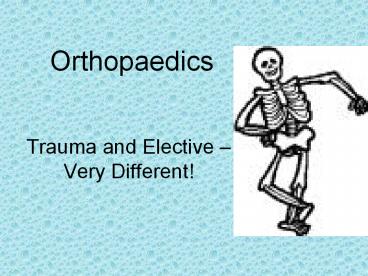Orthopaedics PowerPoint PPT Presentation
1 / 25
Title: Orthopaedics
1
Orthopaedics
- Trauma and Elective Very Different!
2
Trauma
- Patient Group Anyone!
- Can have any injury possibly multiple injuries
including soft tissue - Patients can be quite ill
- All unplanned admissions following an incident
3
Elective
- Patient Group
- Usually older 60
- Healthy
- Generally alert and orientated
4
Elective
- All Planned admissions
- Patients are well dont get surgery if they are
ill - Patients know what to expect it is all
explained before - Wound only other injury
5
Physiotherapists Role
- Mobilising
- Gait Re-education
- Walking aids
- Improving ROM
- Monitoring swelling
- Improving muscle power
- Arranging OP physio
6
MDT
- Important to liaise with all members and be aware
of others jobs - Crucial to follow consultants instructions
- Ensure pain is controlled
- Very integrated physios play a major role in
patient status e.g. for discharge.
7
Assessment
- Elective
- Pre-op,
- Basic subjective and objective,
- Predominantly hip and knee
- Trauma
- After the incident,
- Also soft tissue injuries
8
Complications
- Infection
- Blood Loss
- DVT
- Reactions to Drugs
- Compartment Syndrome
- Dislocation
- Fat Embolism
9
Transferable Knowledge
- Assessment
- Gait Re-education
- Use of walking aids
10
ELECTIVE ORTHO
- Pre assessment clinic or in ward
- Subjective
- Objective hip or knee
- Pre op talk
11
Pre op talk
- Post op regime
- Circulation exs
- Chest care and o2 therapy
- Catheter and drains, IV fluids, PCA
- Splints
- Bed mobility, bridging
- Measure for ZWA
12
Post op regime THR
- POD 1 chest care, TAQs and gluts, bed exs,
measure ROM - POD 2 check x-ray, T/Fs, leg elevated
- POD 3-7 progress to E/Cs, gradual ? exs and
tolerance, stair practice
13
Post-op regime TKR
- POD 1 chest care, TAQ-s and gluts, AROM and
PROM - POD 2 check x-ray, mobilise, T/Fs, ? AROM and
PROM, ? quads - POD 3-7 - ? mobility, cryocuff after dressings
reduced drains removed, progress to sticks and
stair practice
14
Trauma to the Upper Limb
- Humeral
- Nerves that may be affected when the associated
part of the humerus is fractured - Surgical neck ? axillary nerve
- Radial groove ? radial nerve
- Distal end of humerus ? medial nerve
- Medial condyle ? ulnar nerve
15
- Olecranon
- Pinning often required because of the traction
produced by the tonus of the triceps - Supracondylar
- Radius and/or Ulna
- Colles
- Usually results from a fall on an outstretched
hand - Bony union usually good because of rich blood
supply to distal end of radius - Scaphoid
- Most frequently carpal bone
- Possibility of avascular necrosis
16
Other conditions
- Pathological
- Infection
- Removal of metal work
- Cellulitis
- Spinal, clavicle, pelvic
- Compartment syndrome
- Drug related problems
17
Management
- Conservative measures
- Immobilisation in slings, collar and cuff,
tubigrip, splinting materials, plaster of paris
(POP), backslabs - Internal Fixation
- Screws, plates, intramedullary nailing, wiring
- External Fixators
18
Lower Limb
- NOF
- Typical pts elderly falls, osteoporosis,patholog
ical - Types
- Intracapsular subcapital or transcervical
- (avascular necrosis)
- Extracapsular intertrochanteric or
transtrochanteric
19
- Fixation
- Cannulated screws incomplete, impacted
- Hemiarthroplasty (Moores/Bi-polar)
- Dynamic Hip Screw (DHS) intertrochanteric
- Plates and Nails extracapsular
- NB Normally FWB as tolerated 1st day post-op
20
TYPES OF FIXATION
CANNULATED SCREWS
BI-POLAR
DYNAMIC HIP SCREW
MOORES
21
- Knee
- Typical pts High energy trauma,ie RTA, direct
blow/fall - Types
- Supracondylar Femur intra/extra articular,
uni/bicondylar - Patella longitudinal, transverse, comminuted
- Tibial Plateau intra-articular
- Avulsion violent quads contraction
- Fixation
- Undisplaced long leg POP cast NWB
- Displaced/comminuted ORIF PS, dynamic
compression screw - Tension Band Wiring some Patella s
- External Fixation severely comminuted plateau
22
PATELLA AND FIXATION
23
- Tibia / Fibula s
- Typical pts RTA, sporting injuries, twisting
injuries - Types
- Transverse
- Oblique/spiral
- Comminuted
- Fixation
- Stable cast immobilisation, Steinmann pins (NWB)
- Unstable/displaced ORIF, PS, compression
plates, IM nail - Contaminated unstable External Fixation
- NB Compartment Syndrome big risk ? Fasciotomy
24
- Ankle/Foot
- Typical pts Abbduction, adduction, ext.rot,
vertical compression. - Types
- Medial/Lateral malleoli
- Posterior malleolus
- Talus (avascular necrosis)
- Calcaneum
- Fracture dislocations
- Fixation
- Conservative POP,Moonboot, AFO
- ORIF screws, plates, tension band wiring
25
ANKLE FRACTURES

